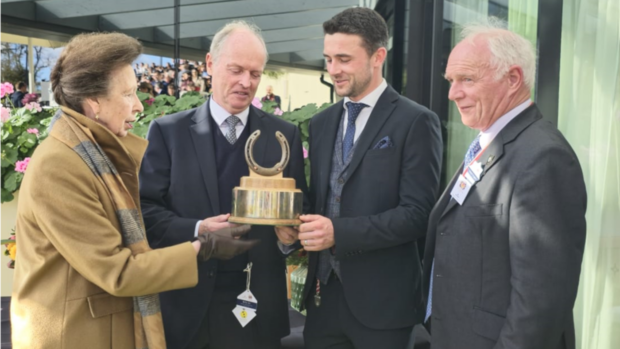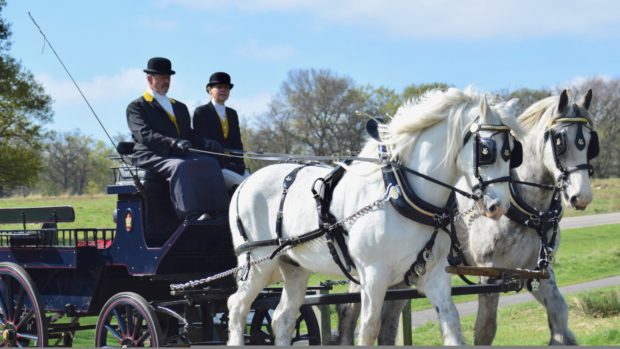Watching great state occasions like Trooping the Colour or a royal wedding, you can’t help but be entranced by the gleaming horses who make up the pomp and ceremony. Horse & Hound visits the Royal Mews in central London to find out what life is like for these horses
1. An impressive working stables
Since the 19th century the Royal Mews at Buckingham Palace has been home to the royal collection of coaches and carriages, playing an important role in state and ceremonial occasions, such as The Queen’s Coronation, royal weddings and Trooping the Colour. It is also one of the finest working stables in existence, home to over 30 Windsor Greys and Cleveland Bays — the horses that pull the royal carriages.
2. A long history

George IV commissioned John Nash to design the present Royal Mews in 1822. The new stables were completed by 1825.
3. The name game
Horses at the mews are often named after places The Queen has visited, royal names or military ranks.
4. The breeds
Today there are two types of horse at the mews. The Windsor Grey has been bred by the royal family since the 19th century — most of the greys are Irish draughts, selected for their coat colour. The other breed is the Cleveland Bay. In 1961 the Cleveland Bay stallion Mulgrave Supreme was bred in North Yorkshire by the late George Duell and was later purchased by The Queen, becoming an important bloodline in saving the breed.
5. Dazzling coaches

Among the dazzling coaches and carriages on permanent display are the Diamond Jubilee State Coach and the Irish State Coach, both of which have been used by The Queen to travel to the State Opening of Parliament, and the Glass Coach, in which royal brides, including The Queen when Princess Elizabeth, have travelled on their wedding day. The most important and best-known vehicle housed in the Royal Mews is the Gold State Coach, which has been used to transport the monarch for every coronation since 1821, including The Queen’s on 2 June 1953. The Gold State Coach was last used on 4 June 2002 to take The Queen and Prince Philip to a service of thanksgiving at St Paul’s Cathedral, as part of the Golden Jubilee celebrations.
6. The messenger Brougham carriage
The messenger Brougham carriage sets out daily from the mews to transfer post between royal residences, a task that has taken place since 1843.
7. The stables

The horses are kept in loose boxes with shavings (pictured above), which are large enough for them to turn around in and lie down. In the past, horses in the state stables were kept in standing stalls (pictured below) wearing a headcollar attached to their manger, but the loose boxes were introduced several decades ago.

8. Master of the Horse
The first Master of the Horse was created in 1340. They are the honorary head of the Royal Mews and rank immediately after the Lord Steward and the Lord Chamberlain. The Master is no longer involved with the day-to-day running of the mews but still makes inspections and rides in ceremonial uniform at state occasions.
9. Coachman and liveried helpers
At the mews there is a head coachman, a deputy and four other coachman. Each coachman has responsibility for approximately eight horses and is assisted by a team of four liveried helpers, who muck out, exercise the horses and clean the tack.
10. The carriage restorer
The carriage restorers are responsible for the overall maintenance of the carriages, including repairing nicks and scratches whilst being driven on the roads. The senior carriage restorer is a fourth generation member of the royal mews staff and trained over a five-year apprenticeship. All painting is carried out by hand and there are usually 15 coats of paint applied to the carriages and wheels, and up to 21 coats on the panels, including varnish.
Continued below…
Liked this? You may also enjoy reading these articles…

Windsor grey retires from royal service to join old friends
“It is a privilege to provide a tranquil

20 beautiful horses among 31 incredible gifts given to The Queen
Knowing what to give The Queen as a
11. The saddlers
The saddlers work with all the leatherwork on the bridles, saddles and harnesses. The state harness is particularly important with some of the oldest components still in use today, almost 300 years after its creation.
12. Rehearsals at the crack of dawn
Three or four days before an important state occasion, such as Trooping the Colour or a state visit, all the necessary horses and carriages take part in an early morning rehearsal to avoid the London traffic. Everyone is back at the mews by 6am.
13. Hyde Park exercise
The horses leave the mews at 6am and are ridden to Hyde Park or St James’s Park to allow them to do some off-road work.
14. The riding school

The riding school was built soon after George III purchased Buckingham House, now known as Buckingham Palace, in 1762. At this time the horses’ stables were at the other end of the Mall, close to Charing Cross, and were moved here when the Royal Mews was built in 1825. The arena has been used by many generations of the royal family, both by children learning to ride and monarchs practising before state occasions.
15. Summer holidays
During the summer the horses go on holiday to stables at Hampton Court Palace, where there is also the stud.
Visit the Royal Mews
The Royal Mews is typically open from February to November. It is closed during state visits and royal events — check website below for details.
The Ascot Landau carriage that transported The Duke and Duchess of Sussex through the streets of Windsor after their wedding ceremony on 19 May 2018 is on public display at the Royal Mews until 30 September 2018.
For more information about guided tours and family activies, visit: royalcollection.org.uk
For all the latest equestrian news and reports, don’t miss Horse & Hound magazine, out every Thursday




